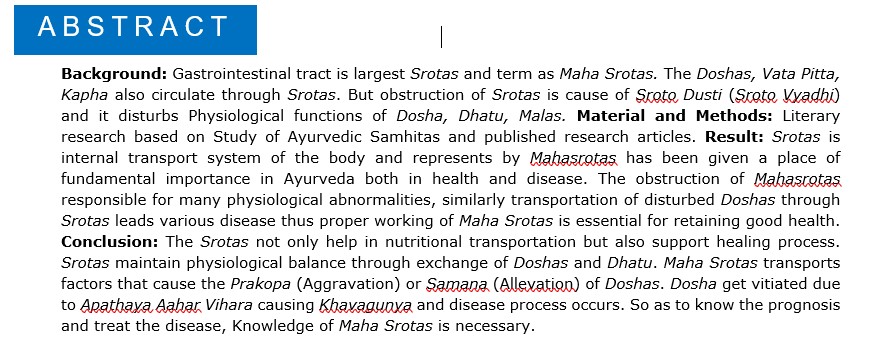Concept of Maha Srotas - A literary review on the basis of fundamental principal
DOI:
https://doi.org/10.21760/jaims.9.6.48Keywords:
Srotas, Mahasrotas, Annavahasrotas, Channels, Sroto DusthiAbstract
Background: Gastrointestinal tract is largest Srotas and term as Maha Srotas. The Doshas, Vata Pitta, Kapha also circulate through Srotas. But obstruction of Srotas is cause of Sroto Dusti (Sroto Vyadhi) and it disturbs Physiological functions of Dosha, Dhatu, Malas. Material and Methods: Literary research based on Study of Ayurvedic Samhitas and published research articles. Result: Srotas is internal transport system of the body and represents by Mahasrotas has been given a place of fundamental importance in Ayurveda both in health and disease. The obstruction of Mahasrotas responsible for many physiological abnormalities, similarly transportation of disturbed Doshas through Srotas leads various disease thus proper working of Maha Srotas is essential for retaining good health. Conclusion: The Srotas not only help in nutritional transportation but also support healing process. Srotas maintain physiological balance through exchange of Doshas and Dhatu. Maha Srotas transports factors that cause the Prakopa (Aggravation) or Samana (Allevation) of Doshas. Dosha get vitiated due to Apathaya Aahar Vihara causing Khavagunya and disease process occurs. So as to know the prognosis and treat the disease, Knowledge of Maha Srotas is necessary.
Downloads
References
Jadavji Trikamji Acharya, Charak Samhita of Agnivesh elaborated by Charak & Dridhabala, with Ayurveda Dipika Commentary, Chapter 5th, Vimansthan Chaukhamba Surbharati Prakashan, Varanasi 2005, Page no. 250.
Ranade S. Deshpande R. & Chobhe S. Sharirkriya Vijnan, Vol. 2, Chapter 5, New Delhi; Chaukhamba Sanskrit Pratisthan, Page no. 47
Ghanekar B. G. Sushruta Samhita, Ayurvedrahasyadeepika hindi commentary, Sharirsthana, Chapter 9 verse: 11, Reprint edition, New Delhi; Meharchand laxman das publication; 2009; Page no. 238
(4). Sharma P V, editor, text with English translation, Charak Samhita, Volume - 1, Vimansthana; Chapter 5, Reprint ed. Varanasi; Chukhambha Orientalia, 5/4 2011; Page no. 330
P.V.Sharma editor–translator. Caraka Samhita Vol.I. Reprint ed. Varanasi: Vimansthana, Chapter 5 Reprint ed. Varanasi; Chukhambha Orientalia, 5/5 2011; Page no. 329
P. V. Sharma editor–translator. Caraka SamhitaVol.1 Reprint ed. Varanasi: Chaukhamba Orientalia, Vimansthana, Chapter 5, 5/6 2011; Page no.333
K.R. Srikantha murthy editor, Susruta Samhita Vol. 2 , 1 st ed. Varanasi Chaukhamba Orientalia, Sharir sthan 2001,Page no. 80.
K. R. Srikantha Murthy editor. Susruta Samhita. Vol-II. 1st ed. Varanasi: Chaukhamba Orientalia. Appendix, 2001; Page no. 224.
P. V. Sharma editor–translator. Caraka SamhitaVol.1 Varanasi: Chaukhamba Orientalia, Vimansthana, 5/6 Page no.333.
Agnivesha, Charaka Samhita Volume I, Vimana sthana Chowkhamba Sanskrit Santhana, Varanasi Prakashan; 6 ed. 2000, 5/3 Page no. 590.
Charak samhita with Ayurved Dipika Commentry of Chakrapanidatta, Purvardha, Vd. Y. G. Joshi, Vaidyamitra prakashan, reprinted, Vimansthan, 2013; 5/8: 541.
Vd. Athvale, Vd. P. G. Athvale,Drushtartha Sushrut chintan with Nibandh sangrah commentary of Dalhana, Nyaychandrika commentary of Gaydas and Padmini Tika of Part 1,Shree Dhanvantari Books Publishers, Nagpur, repainted, 2017; 9/12: 611.















